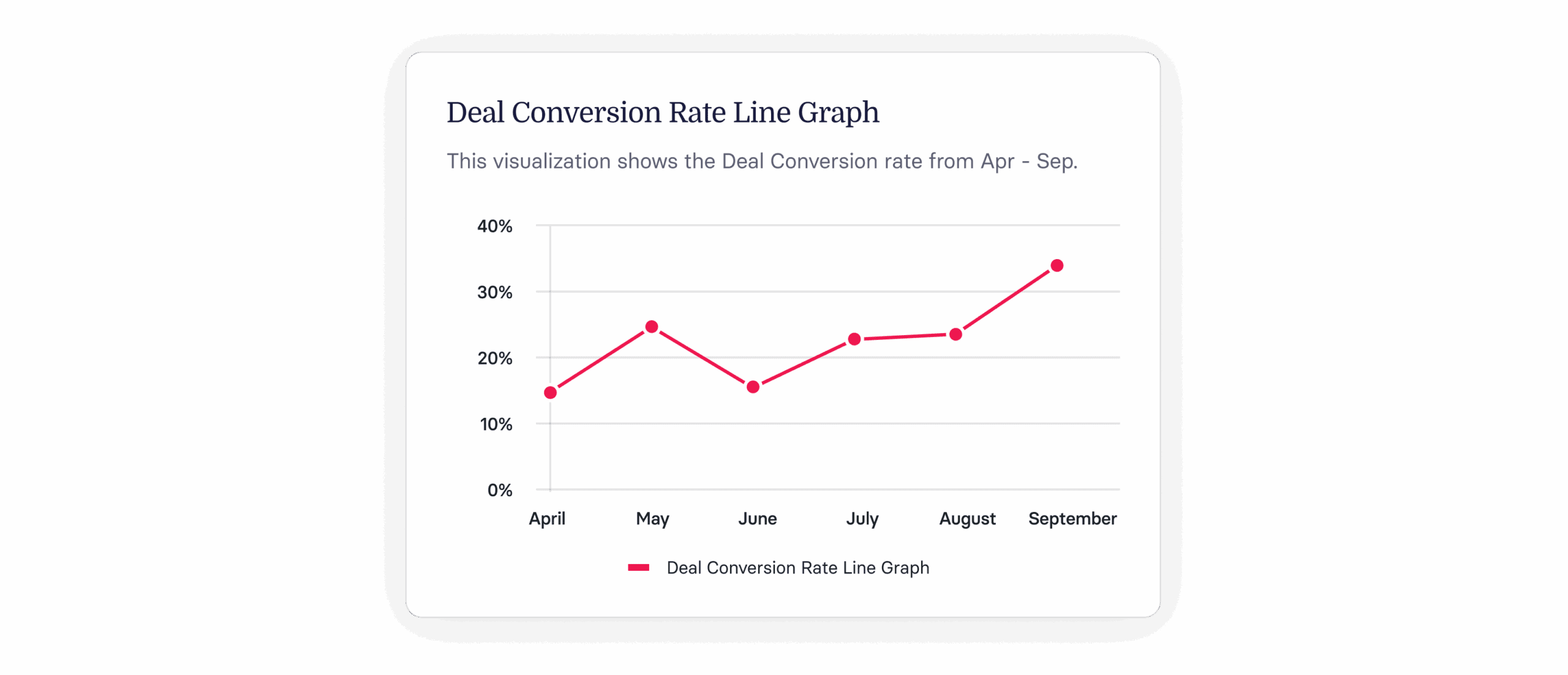Sales conversion rate—also called deal conversion rate—is the percentage of opportunities that result in closed-won deals.
What is sales conversion rate?
As a key sales funnel metric, sales conversion rates help assess the effectiveness of both sales and marketing efforts. It also sheds light on why deals are won or lost and how prospects perceive the value of your product.
<<Download the SaaS metrics cheat sheet today!>>

The sales conversion rate highlights closed-won deals, but the remaining percentage reveals the rate of closed-lost opportunities. Analyzing when leads convert—or drop off—at different funnel stages (top, middle, or bottom) can offer valuable insights. This deeper view supports more strategic conversations between sales and marketing, helping teams make informed decisions about where to improve efficiency and focus their efforts.
How to calculate sales conversion rate
To calculate your sales conversion rate, divide the number of closed-won deals by the total number of opportunities, then multiply by 100 to get the percentage.

Sales conversion rate is a valuable metric across the entire funnel. For sales teams, it highlights where prospects may be getting stuck—and helps identify ways to guide them toward a closed-won outcome. For marketing teams, it’s a useful starting point for evaluating the quality of leads, sales-qualified leads (SQLs), and opportunities being generated.
A consistently low conversion rate might signal a few things: misalignment with your ideal customer profile (ICP), product-market fit challenges, or gaps in conversion rate optimization across key touchpoints like your website.
Why is sales conversion rate important for SaaS companies?
Reviewing sales conversion rates across the sales cycle does more than measure performance—it creates opportunities for cross-functional collaboration between finance, marketing, and sales. Together, these teams can dig into the “why” behind the numbers.
Finance teams can help identify patterns in closed-won versus closed-lost deals, offering insights that inform adjustments in marketing campaigns and sales tactics. With shared visibility, teams can make more strategic, data-driven decisions that improve conversion rates across the funnel.
Even small improvements in deal conversion rates can lead to meaningful gains in revenue and reduce customer acquisition costs (CAC) over time.
Real-time data tracking helped revenue.io achieve strategic insights
Revenue.io saw the importance of tracking sales conversion rates more effectively after expanding its product line through SaaS subscriptions. The aggressive expansion strategy brought in more customers—and with them, more data to manage. Analyzing new business pipelines alongside cross-sell potential became increasingly complex and time-consuming, especially with manual data gathering.
To keep up, the company needed to revamp its systems. That meant making data easier to access, analyze, and translate into clear, SaaS-specific insights for both product and sales teams. Finance played a key role in streamlining these processes, ensuring that decision-makers could focus on strategy—not just data prep.
“As the number of customers and products grew, we were tasked with finding a way to scale our workflows, analyze new business, and expand revenue against our existing base. This puts pressure on finance to find faster ways to deliver insights in support of our vision.”
— Kanwar Saluja, COO, Revenue.io
By integrating their Salesforce data with purpose-built dashboards, the finance team cut back significantly on manual work. Real-time visibility allowed sales teams to forecast with greater accuracy, and finance gained the insight needed to benchmark the sales cycle and assess how product improvements impacted growth.
<<Get a head start on your top-line planning with this sales capacity model template.>>
Understanding your sales conversion rate
Even with a strong sales conversion rate, the number alone doesn’t tell the full story. To make more informed, proactive decisions, it’s essential to view this metric alongside others across the sales and acquisition journey.
For example, top-of-funnel conversion rates can reveal how well you’re building awareness and sparking interest. Mid-funnel rates might highlight where leads drop off between marketing-qualified (MQLs) and sales-qualified (SQLs), helping sales teams refocus their efforts. At the bottom of the funnel, deal conversion rates can pinpoint where improvements are needed between evaluation and purchase.
Whether you’re taking a detailed look or zooming out to a high-level view, understanding conversion trends across the funnel can enhance revenue forecasting, budgeting, and strategy planning across your go-to-market team.
Key takeaways
- Sales conversion rate, an essential metric for SaaS sales teams, measures the percentage of deals closed-won relative to total opportunities
- Understanding this rate helps identify the effectiveness of sales and marketing strategies, highlighting areas for improvement and collaboration
- Calculating sales conversion rate involves dividing conversions by total opportunities and multiplying by 100 to get a percentage
- A strong focus on conversion rate can reveal insights into customer behavior, product-market fit, and sales funnel efficiency
- Cross-departmental collaboration enhances conversion rate optimization by identifying key metrics, improving customer targeting, and refining sales processes
Other important sales metrics for SaaS companies
Sales metrics and KPIs offer essential insights into the performance of both sales and marketing teams. Taking a deeper look at sales funnel and performance metrics can uncover opportunities to strengthen the pipeline and understand how those improvements affect broader KPIs across teams and company-wide goals.
Here are some key SaaS sales metrics to help you get the most value from your sales conversion rate.
Recommended For Further Reading
Total and type of leads
Tracking lead generation—and understanding how and when leads enter the sales cycle—helps sales and marketing teams connect campaigns to lead quality, refine the ideal customer profile (ICP), and gauge buyer readiness.
Finance can take it a step further by analyzing where MQLs and SQLs tend to convert or drop off in the funnel. These insights can guide marketing and sales teams in refining their strategies, identifying what’s working, and improving what’s not.
Opportunities created
Tracking the number of opportunities over a specific period helps shape pipeline projections and forecast revenue from sales conversions. This data is especially useful for marketing, offering visibility into which campaigns and business development strategies are driving real results.
Average sales cycle
Average sales cycle is a core sales performance metric—and a strong indicator of revenue potential. It tracks the average number of days from when an opportunity is created to when it’s won. Monitoring this metric helps sales and marketing teams identify ways to streamline the funnel and move prospects through more efficiently.
Average deal size
Tracking average deal size provides valuable insights into your sales process, pipeline quality, and team performance. It helps pinpoint high-value opportunities with strong conversion potential and sharpens your lead qualification strategy. Over time, it also serves as a strong predictor of overall revenue growth.
Opportunities won
Comparing closed-won opportunities to your forecasts helps reveal where gaps exist between expectations and outcomes. Significant discrepancies may point to areas for improvement—whether in your sales cycle, lead qualification, or forecasting methods—and give your team a clearer path to refine future projections.
Closed-won/lost summary
Tracking both won and lost deals gives a more complete view of your sales effectiveness. It helps you evaluate how well your sales process is working and offers valuable insight into whether your product is truly resonating with your target market—an essential step toward achieving product-market fit.
Retention and churn rates
For SaaS companies, tracking churn and retention is essential. Customer retention offers key insights into the effectiveness of onboarding, support, and overall satisfaction. On the flip side, monitoring churn helps identify where improvements are needed—whether in product experience, engagement, or support—so teams can focus their efforts where it matters most.
Customer acquisition cost
Tracking customer acquisition cost (CAC) is essential—it reflects how efficiently your marketing and sales efforts translate into closed-won deals. By comparing total acquisition costs to the number of deals won, you can better forecast future investments and ensure your growth strategy supports continued gains in monthly recurring revenue (MRR) and annual recurring revenue (ARR).
4 ways to improve your sales conversion rate
Improving conversion rates requires close collaboration across sales, marketing, and finance. Here are four ways cross-functional teams can work together to drive stronger outcomes.
1. Strengthen customer targeting and lead generation
Effective conversion starts with attracting the right leads. Using channels like PPC, SEO, social media, and email, marketing can test and refine campaigns to reach ideal customers. Tracking the performance of each campaign helps identify which strategies convert best—and where to adjust spend or messaging to improve ROI.
2. Align on key metrics across the sales funnel
Conversion doesn’t just happen at the bottom of the funnel. Finance, sales, and marketing can work together to define key metrics at every stage of the buyer journey. This shared visibility helps teams identify roadblocks, replicate what’s working, and stay focused on strategies that drive meaningful impact.
3. Optimize product-market fit with financial insights
Finance can help spot potential gaps in product-market alignment by analyzing metrics like average deal size, sales cycle length, and churn. Reviewing conversion rates—especially closed-won vs. closed-lost—can highlight where prospects are dropping off. These insights help teams refine positioning and outreach to better meet the needs of your target market.
4. Analyze deal conversion rates by type
Looking at closed-won and closed-lost deals in relation to open opportunities helps gauge sales efficiency. By digging into conversion trends by campaign or deal type, teams can identify what’s driving success—and where adjustments are needed. These findings empower marketing to double down on high-performing efforts and share learnings across the funnel.
Get real-time insights into your sales conversion rate
Tracking your sales conversion rate is essential to business success—and finance plays a key role in surfacing and analyzing that data. But without the right tools, gathering and organizing the numbers can eat up valuable time that could be better spent on strategic analysis.
Modern financial tools can help simplify the process by providing real-time access to your sales conversion rate and related metrics. Customizable dashboards make it easier for finance to track performance, measure trends across time periods, and quickly drill into the details—like which deals were won or lost.
With faster, clearer visibility, your team can shift from data collection to decision-making—empowering cross-functional collaboration and enabling more proactive, growth-focused strategies.
With tools like a sales cycle dashboard, you can view key data at a glance—freeing up time to collaborate across teams and focus on improving sales conversion rates. Real-time access to metrics means less time spent on manual reporting and more time for strategic planning.
Looking to simplify how you track and analyze sales performance? Explore how modern financial tools can help your team make smarter, faster decisions.
Sales Conversion Rate FAQs
What role does A/B testing play in improving a SaaS company’s sales conversion rate?
A/B testing is a powerful tool for SaaS companies looking to refine their sales strategies. By testing different versions of elements like landing pages or calls to action (CTAs), teams can see what drives higher conversion rates. These insights help optimize customer acquisition efforts and build a more effective, data-driven approach to growth.
How does conversion rate optimization contribute to acquiring new customers?
Conversion rate optimization (CRO) focuses on improving each step of the sales and marketing process to increase the percentage of visitors who take a desired action—like subscribing or making a purchase. Strong CRO strategies make sure that every element, from landing pages to calls to action (CTAs), is designed to guide potential customers toward conversion.
Is sales velocity the same as conversion rate?
Sales velocity and conversion rate are related but distinct metrics. Sales velocity measures how quickly deals progress through the pipeline—giving insight into the speed of your sales process. Conversion rate, on the other hand, looks at the percentage of prospects that move from one stage to the next, helping assess the effectiveness of your funnel at each step.

